| T O P I C R E V I E W |
| Xavier |
Posted - 14/08/2012 : 11:20:05
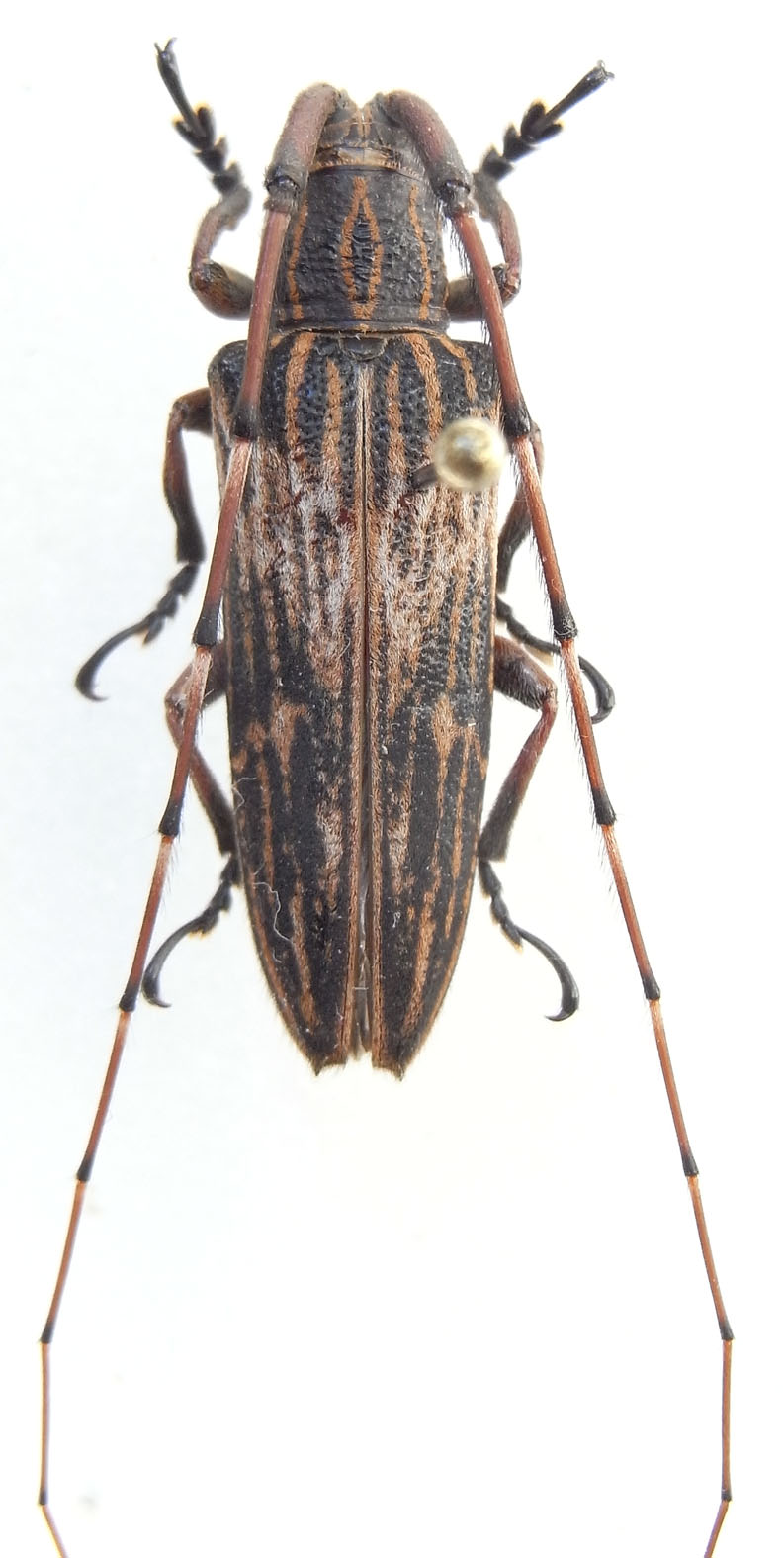
21 mm. Hua Phan, nord Laos.
Une Phelipara aux tibias antérieurs échancrés, 8 bandes sur le pronotum (en en comptant 2 au milieu du pronotum !).
Le 3ème article antennaire plus long que le scape m'oriente vers Phelipara laosensis Breuning, 1964. Mais la dimension donnée par Breuning, 14 mm, ne colle pas ( mais sur un seul exemplaire !).
Une ressemblance avec Phelipara marmorata Pascoe, 1866, mais les bandes du pronotum me semblent différentes... |
| 15 L A T E S T R E P L I E S (Newest First) |
| woshixiao |
Posted - 08/05/2019 : 10:45:58
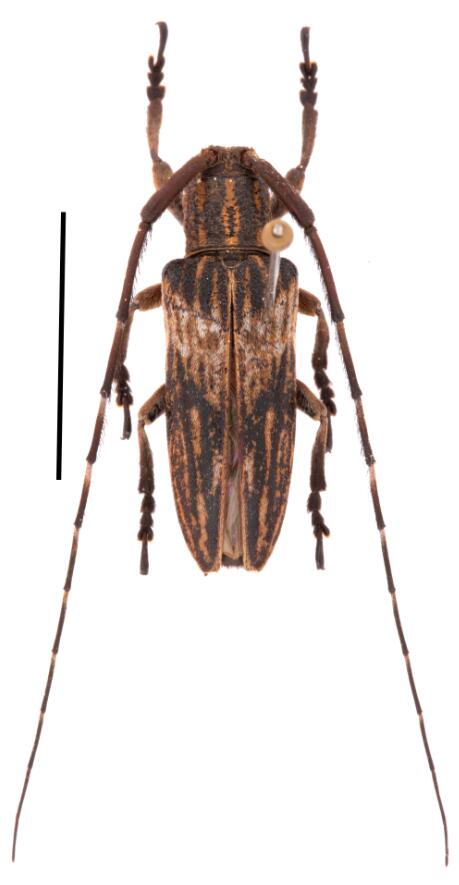
29.74 KB
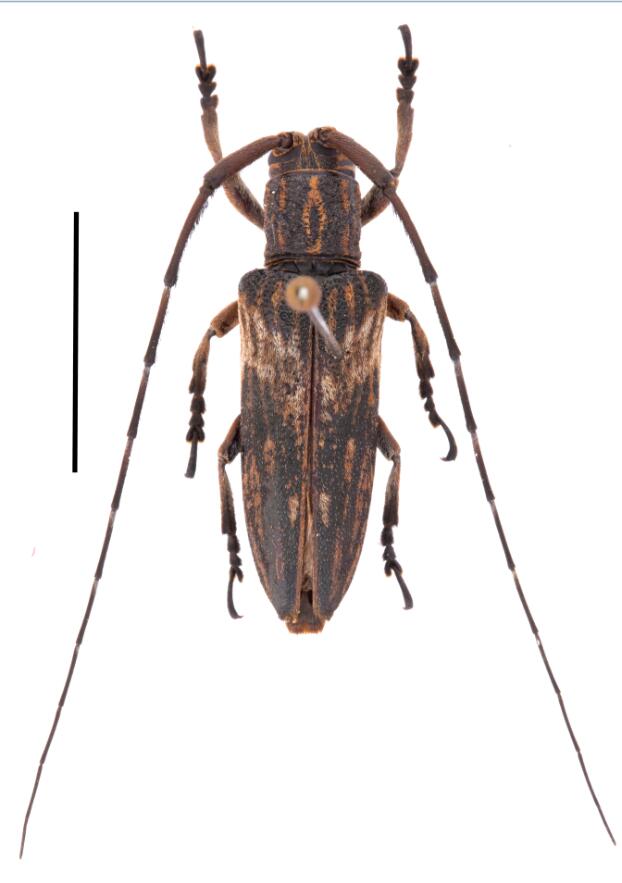
35.42 KB
I have two specimens from Hubei China,I still don't understand. |
| Francesco |
Posted - 19/09/2012 : 20:58:58
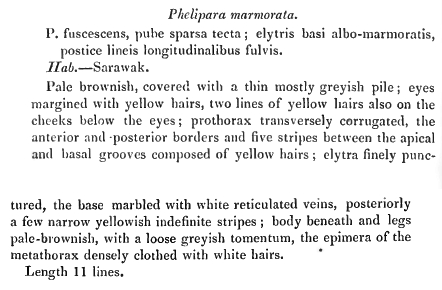
Phelipara marmorata was described in Longicornia Malayana.
The main difference I find is that the whitish part is basal (or sub-basal?) in this species, pre-median in your one (= Paranandra laosensis?), and absent in Potyne submarmorata. |
| Xavier |
Posted - 19/09/2012 : 20:49:38

Here a picture from the forum (Gérard Chemin) of Phelipara marmorata.
None of the 3 specimens are Phelipara marmorata. |
| Xavier |
Posted - 19/09/2012 : 20:38:01
I try to follow... Why, Petr, are you sure that the middle picture is not Phelipara marmorata, and, in this case, what differences do you see between this middle picture and the two others specimen ?
It could be interesting to have the original description of P. marmorata, to purchase our investigation. |
| Francesco |
Posted - 19/09/2012 : 20:07:49
I agree, Petr.
The other interesting fact is that the holotype of Paranandra laosensis also belongs to the collection Tippmann (and to the Smitsonian as well)...
Here the pre-median light band is surely absent.
May it be the holotype of Potyne submarmorata? |
| Petr Viktora |
Posted - 19/09/2012 : 19:48:36
On the middle picture sure is not Phelipara marmorata.
On that we agree.
Steven Lingafelter can answer questions about photo from the Smithsonian Institution.
Detective investigation can continue. Petr |
| Francesco |
Posted - 19/09/2012 : 19:10:44

Here the problems are multifarious.
The type (or the specimen supposed as such) does not seem to be a Pothyne (here we all agree).
Secondly, it does not correspond to the original description.
In fact the text marked in yellow states: "Each elytron with 7 reddish-ochre yellow longitudinal bands, which are little evident on the basal part, entire in the middle, partially interrupted also after the middle, and little visible on the apical part."
P. submarmorata is my mistake, I'd write P. marmorata...  |
| Xavier |
Posted - 19/09/2012 : 18:12:56
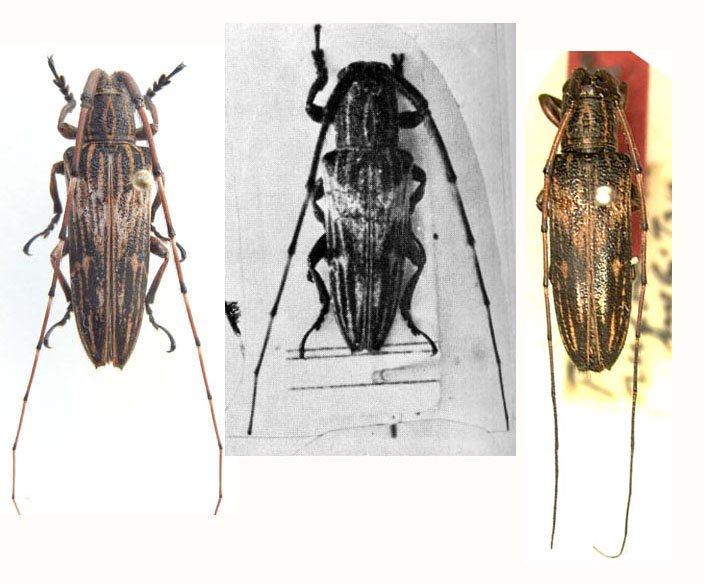
On the picture :
1. species coming from Laos (mine's). 21 mm.
2. picture of Gressitt (1970), fig 14d named Phelipara (s.st.) marmorata page 373 & 374. size 13 to 18 mm
3. holotype of Pothyne rufovittata Breuning, from Smithsonian |
| Petr Viktora |
Posted - 19/09/2012 : 16:37:58
I responded to the above sentence
"Later, if Paranandra laosensis Breuning, 1942, Phelipara submarmorata Breuning, 1960 and Pothyne rufovittata Breuning, 1960 are (all or partially) actually the same species, this is another serious doubt..."
I have no reason to think that the type of Pothyne rufovittata is bad.
I'm interested in other groups of Cerambycidae, it's just my opinion. |
| Xavier |
Posted - 19/09/2012 : 16:17:21
Well, it's not easy in english. I have never spoken about Phelipara submarmorata.
One thing is the mistake of picture in Gressitt's book, but in the other hand, there is also the mistake about the holotype of Pothyne rufovittata in Smithsonian.
OR, do you think that this holotype is a "good" Pothyne rufovittata ??? |
| Petr Viktora |
Posted - 19/09/2012 : 15:46:16
I do not see where you're looking for a problem.
Phelipara submarmorata and Pothyne rufovittata are not the same.
Phelipara submarmorata is correctly determined elsewhere in this forum.
I repeat, in image boards (Rondon and Breuning, 1971) are errors.
I am also of the opinion that it is not a genus Pothyne but Phelipara, it is another thing. |
| Xavier |
Posted - 19/09/2012 : 08:30:18
Well, for me these differences are very light on picture. The type has 60 years old and could be geasy, but habitus and patterns are so close...The main problem at all is not about same or different species . We can think that Breuning has made a mistake about the genus of this species, and to prove that, it's necessary to examin the holotype !
After that, it could be easy to say if my specimen is the same or not species. So, the question is : how find the type ? |
| Francesco |
Posted - 18/09/2012 : 23:15:39
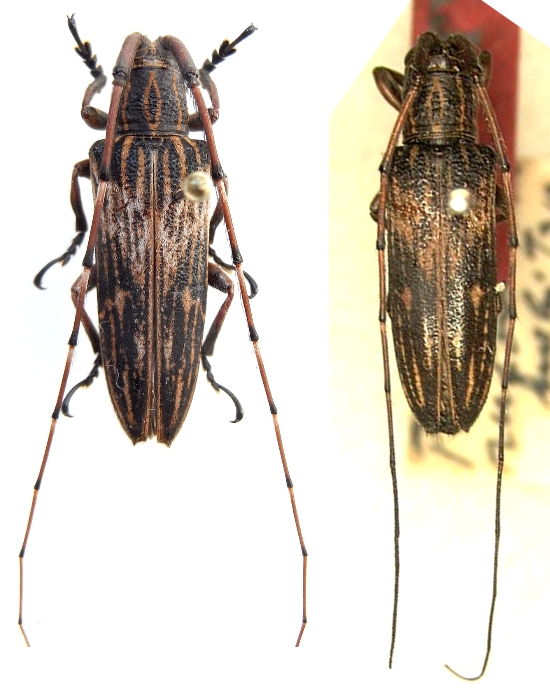
Actually, I am not sure that these are actually the same species. There are some differences:
The antennae are bicolour in your specimen, while they apically black starting from the antennomere VII in the type.
The elytral shape is more apically convergent in your specimen, while it is nearly parallel in the type (similar to Pothyne?)
The elytral pattern is analogue, but the orange one is more defined and developed in your specimen.
And... dulcis in fundo... the original description of P. rufovittata does not mention any transversal white, whitish or light band! |
| Xavier |
Posted - 18/09/2012 : 22:58:29
I share your doubt : it's doesn't looks like a Pothyne species.
But after seeing the type specimen, I don't know what thinking. What another mystery ! |
| Francesco |
Posted - 18/09/2012 : 22:52:21
This species gives me many doubts.
First of all, it does not belong to the genus Pothyne, which all have more delicate habitus, parallel-sided elytra, scarcely elevated antennal supports, and feebly reclined head (there are several species in the Forum).
If we use Breuning's keys (1966 and 1970), the doubt may be between Phelipara and Paranandra.
Later, if Paranandra laosensis Breuning, 1942, Phelipara submarmorata Breuning, 1960 and Pothyne rufovittata Breuning, 1960 are (all or partially) actually the same species, this is another serious doubt... |


